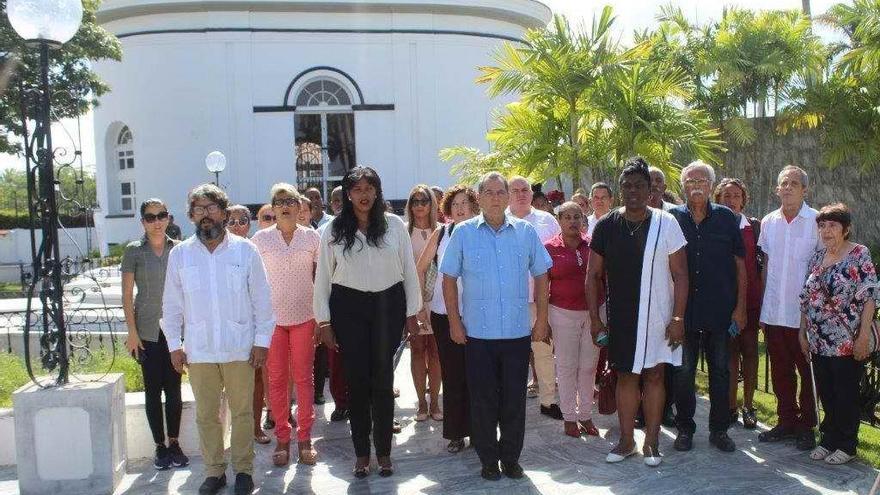
![]() 14ymedio, Juan Izquierdo, Havana, 29 August 2022 — The imposing funerary pyramid of Emilio Bacardí Moreau, who died on 28 August 1922, is not far from the mortuary stone of Fidel Castro, the man who dismantled the rum distillery and the cultural legacy of the Bacardí family.
14ymedio, Juan Izquierdo, Havana, 29 August 2022 — The imposing funerary pyramid of Emilio Bacardí Moreau, who died on 28 August 1922, is not far from the mortuary stone of Fidel Castro, the man who dismantled the rum distillery and the cultural legacy of the Bacardí family.
One hundred years after the death of the patriot, historian and philanthropist from Santiago, the same regime that expropriated the Bacardí distilleries and buildings intends to pay tribute to the first Republican mayor of Santiago de Cuba.
Tributes and biographical notes in the official newspapers now present Bacardí as a kind of politician precursor of the revolutionary practices of 1959. He is credited with a rabid anti-imperialism, and his business and political acumen is minimized. The issue of rum is taboo, and they almost classify him as a feminist for asking the widows of the mambises to fill positions in the town hall.
Bacardí will attain everything the Cuban regime needs, including a “little war of memory” against the heirs and directors of the company, who are currently based in Bermuda.
However, investigating and quoting Bacardí means playing with fire, because not all those who have contributed to the tribute have expressed themselves in politically “desirable” terms.
Some texts recover the sappy language of the social chronicle of the Republic, in addition to making use of terms such as patrician, eminent and patriarch, inconceivable in the official organs of the Communist Party.
Censorship confronts journalists with a curious dilemma: they must reconstruct the history of Cuban rum manufactured by Bacardí, talk about it as if it were still being distilled on the Island and suspend any reference after 1960.
“If Cuban rum is the best on the planet,” Cubadebate reasons, “in Cuba the best is that of Santiago de Cuba, the one initiated by Facundo and bequeathed by Don Emilio Bacardí Moreau,” the official government site says, without mentioning the expropriations after the triumph of the Revolution or talking about “trademarks.”
In commemorating his death, Bohemia magazine repeats that the initial tomb of the patriot was “humble to the point of surprise” — the phrase is by Fernando Portuondo — but they forget to talk about the sumptuous mausoleum of a millionaire that was later dedicated to him, described as just a “symbolic pyramid structure.”
The “main course” of the tributes was the presentation, once again, of the two volumes of Emilio Bacardí Moreau: on Passionate Cuban Humanism, published in 2018 by the historian Olga Portuondo, a controversial biography of the patriot whose distribution and sale was delayed, until it was almost impossible to find in bookstores.
Successfully, but serving the official appropriation of “uncomfortable” figures, Portuondo introduces the work of Bacardí as the founder of the oldest Cuban museum, as well as the author of the monumental collection Chronicles of Santiago de Cuba and other books, fictional and historical, of smaller scope. He is presented as an intellectual and mambí conspirator, rather than a politician or entrepreneur.
During the commemorations, there was no shortage of those who remembered quietly the “prophetic coconut tree” of Facundo Bacardí. Facundo, father of the Bacardi clan, was the man who, in 1862, coined the symbol of the bat to identify his new technique for distilling rum. In the vicinity of the factory he planted a palm tree that survived earthquakes, wars, fires, independence and flag changes.
“The company will live in Cuba as long as the coconut tree,” the legend said. On October 14, 1960, on the eve of the centenary of the company, the coconut tree just dried up, and Fidel Castro expropriated Bacardi’s premises without compensation.
The family members went into exile, with the “secret recipe” of rum, honey and yeast strains. Several international legal proceedings have been brought against the Cuban government, but none have been successful.
To this day, the most emblematic brand of Cuban rum continues its production in the United States, Mexico, Puerto Rico, Italy and the Bahamas, but not on the Island.
This Sunday, numerous officials, Party leaders and historians aligned with the regime, and some workers of the Provincial Heritage Center, concluded the tribute in front of the mausoleum of the patriot in the cemetery of Santa Ifigenia.
Whipped by the sun of eastern Cuba, and after anachronistic speeches by the members of the Central Committee, none of the attendees were able to toast to the memory of Don Emilio with a drink of Bacardi rum.
Translated by Regina Anavy
____________
COLLABORATE WITH OUR WORK: The 14ymedio team is committed to practicing serious journalism that reflects Cuba’s reality in all its depth. Thank you for joining us on this long journey. We invite you to continue supporting us by becoming a member of 14ymedio now. Together we can continue transforming journalism in Cuba.
